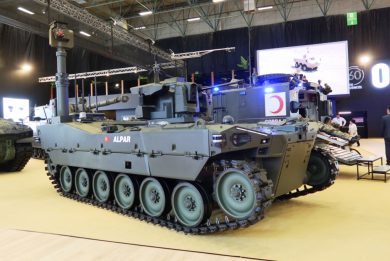
IDEF 2023 – Havelsan Çaka s-kusv, an invisible threat for naval ships
At IDEF 2023 Havelsan unveiled a new concept of unmanned system, the Çaka submersible kamikaze unmanned surface vessel, s-kusv in short
The last pop-up allows the Çaka to acquire its target, an enemy frigate that navigates at a few miles distance. Under the direction of the autonomous battle command system, once received the validation from the command post, the k-usv accelerates to the maximum speed, over the double that of its target, leaving minimum warning time to the crew. Never the definition “out of the blue” is more adapted.

The Çaka which concept has been developed by Havelsan, the project being carried out in cooperation with three partners, Roketsan for the warhead, Asisguard for the electrooptical system and its integration, and Kraken Marine for the hull, Havelsan ensuring the integration and artificial intelligence-based functions.
The Çaka comes in the form of an 8.5 metres trimaran hull with a 3.3 metres beam and a 3.2 tonnes displacement. When operating on the surface the s-kusv is moved by a surface drive propeller powered by one 6-cylinder diesel engine providing 550 hp, this solution ensuring a top speed of over 60 knots. However the beauty of the Çaka is that it can disappear under the surface; here it is powered by two waterjets driven by battery-powered electric engines. Underwater the speed is limited as the Çaka is not aimed at underwater targets such as submarines, but solely at surface targets. The diving capability ensures the killer vehicle to remain stealth, popping up for getting data from the control station; with a declared range of 250 NM for the prototype, the aim being to increase it when the Çaka will become a product, a SATCOM solution might well be considered. However when employed in a defensive posture, to protect high value targets, line-of-sight data links would suffice, antennas being protected by an RF transparent cover. The killer USV can be linked to a dedicated control station, but can also receive information and be monitored by stations deployed on aircraft, or from the COC of a naval ship.

Underwater an inertial navigation system and a dead reckoning system ensure navigation. Contact can be arranged through procedural protocols, for example surfacing at pre-programmed intervals; the prototype will not feature surfacing antennas, but this is a solution that Havelsan has in mind for the final version. Through the link the Çaka receives the Recognised Maritime Picture. Target detection is carried out using day/night optronic systems, AI-based algorithms ensuring recognition and identification, PID confirmation being provided by the man in the loop. Should a target appear beyond-line-of-sight, mission data can be fed via the data link to allow the Çaka to start its attack procedure. Havelsan is working hard on autonomy functions, and in due time the Çaka will also acquire swarming capabilities.
The team is also working on a recovery system that will allow a naval vessel to carry a certain number of Çakas to be used for example for screening the naval formation from potential surface threats, acting also as deterrence, in which case the warhead, fitted with an impact fuse, would not detonate. EDR On-Line understood that the warhead could contain around a few hundred kilograms of explosive, which can however be increased if needed.. The Çaka should therefore become a sort of naval “Loyal Wingman”, the system being also usable in an offensive posture should the need arise.

According to Havelsan the Çaka is cost effective compared to torpedoes and when the swarm capability will be available it could conduct saturation attacks from concealed underwater positions where it can remain for long time. Compared to mines its effectiveness is greater as it is highly mobile, it can be remotely controlled, and it is immune to mine countermeasures.
Havelsan has concluded the concept study phase, following which a Memorandum of Understanding was signed with the three abovementioned companies to start the following phase that will lead to the production of the prototype.
Photos by P. Valpolini



